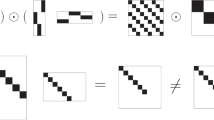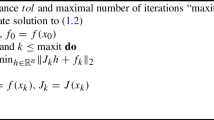Abstract
A least-squares strategy is proposed for representing a two-mode proximity matrix as an approximate sum of a small number of matrices that satisfy certain simple order constraints on their entries. The primary class of constraints considered define Q-forms (or anti-Q-forms) for a two-mode matrix, where after suitable and separate row and column reorderings, the entries within each row and within each column are nondecreasing (or nonincreasing) to a maximum (or minimum) and thereafter nonincreasing (or nondecreasing). Several other types of order constraints are also mentioned to show how alternative structures can be considered using the same computational strategy.
Similar content being viewed by others
References
Barthélemy, J.-P., & Guénoche, A. (1991).Trees and proximity representations (tr. G. Lawden). Chichester: Wiley.
Carroll, J. D. (1980). Models and methods for multidimensional analysis of preferential choice (or other dominance) data. In E. D. Lantermann & H. Feger (Eds.),Similarity and choice (pp. 234–289). Bern: Huber.
Coombs, C. H. (1964).A theory of data. New York: Wiley.
De Soete, G., DeSarbo, W. S., Furnas, G. W., & Carroll, J. D. (1984). The estimation of ultrametric and path length trees from two-mode proximity data.Psychometrika, 49, 289–310.
Ducamp, A., & Falmagne, J. C. (1969). Composite measurement.Journal of Mathematical Psychology, 6, 359–390.
Dykstra, R. L. (1983). An algorithm for restricted least squares regression.Journal of the American Statistical Association, 78, 837–842.
Furnas, G. W. (1980).Objects and their features: The metric analysis of two-class data. Unpublished doctoral dissertation, Stanford University, Stanford, CA.
Gifi, A. (1990).Nonlinear multivariate analysis. Chichester: Wiley.
Hansen, J. C., & Campbell, D. P. (1985).Manual for the SVIB-SCII (4th ed.). Palo Alto, CA: Consulting Psychologists Press.
Heiser, W. J. (1981).Unfolding analysis of proximity data. Unpublished doctoral dissertation, University of Leiden.
Holland, J. L. (1966).The psychology of vocational choice: A theory of personality types and environmental models. New York: Ginn.
Holland, J. L. (1981).Making vocational choices: A theory of careers (2nd ed.). Englewood Cliffs, NJ: Prentice-Hall.
Hubert, L. J. (1974). Problems of seriation using a subject by item response matrix.Psychological Bulletin, 81, 976–983.
Hubert, L. J., & Arabie, P. (1994). The analysis of proximity matrices through sums of matrices having (anti-)Robinson forms.British Journal of Mathematical and Statistical Psychology, 47, 1–40.
Hubert, L. J., & Schultz, J. V. (1976). Quadratic assignment as a general data analysis strategy.British Journal of Mathematical and Statistical Psychology, 29, 190–241.
Kendall, D. G. (1971a). Abundance matrices and seriation in archaeology.Zeitschrift für Wahrscheinlichkeitstheorie, 17, 104–112.
Kendall, D. G. (1971b). A mathematical approach to seriation.Philosophical Transactions of the Royal Society of London, Series A, 269, 125–135.
Kruskal, J. B. (1964). Multidimensional scaling by optimizing goodness-of-fit to a nonmetric hypothesis.Psychometrika, 29, 1–27.
Marks, W. B. (1965).Difference spectra of the visual pigments in single goldfish cones. Unpublished doctoral dissertation, Johns Hopkins University.
Pliner, V. (in press). Metric unidimensional scaling and global optimization.Journal of Classification.
Prediger, D. J. (1982). Dimensions underlying Holland's hexagon: Missing link between interests and occupations?Journal of Vocational Behavior, 21, 259–287.
Robinson, W. S. (1951). A method for chronologically ordering archaeological deposits.American Antiquity, 16, 293–381.
Roskam, E. E. Ch. I. (1968).Metric analysis of ordinal data in psychology. Voorschoten: Drukkerij/Vitgeverij VAM.
Rounds, J. B. (1995). Vocational interests: Evaluating structural hypotheses. In R. V. Dawis & D. Lubinski (Eds.),Assessing individual differences in human behavior: New concepts, methods, and findings (pp. 177–232). Palo Alto, CA: Consulting Psychologist Press.
Schiffman, H., & Falkenberg, P. (1968). The organization of stimuli and sensory neurons.Physiology and Behavior, 3, 197–201.
Schiffman, S. S., Reynolds, M. L., & Young, F. W. (1981).Introduction to multidimensional scaling. New York: Academic Press.
Tracy, T. J., & Rounds, J. (1993). Evaluating Holland's and Gati's vocational-interest models: A structural meta-analysis.Psychological Bulletin, 113, 229–246.
Tucker, A. (1972). A structure theorem for the consecutive 1s property.Journal of Combinatorial Theory, Series B, 12, 153–162.
Tucker, L. R. (1972). Relations between multidimensional scaling and three-mode factor analysis.Psychometrika, 37, 3–27.
Author information
Authors and Affiliations
Rights and permissions
About this article
Cite this article
Hubert, L., Arabie, P. The approximation of two-mode proximity matrices by sums of order-constrained matrices. Psychometrika 60, 573–605 (1995). https://doi.org/10.1007/BF02294329
Received:
Revised:
Issue Date:
DOI: https://doi.org/10.1007/BF02294329




